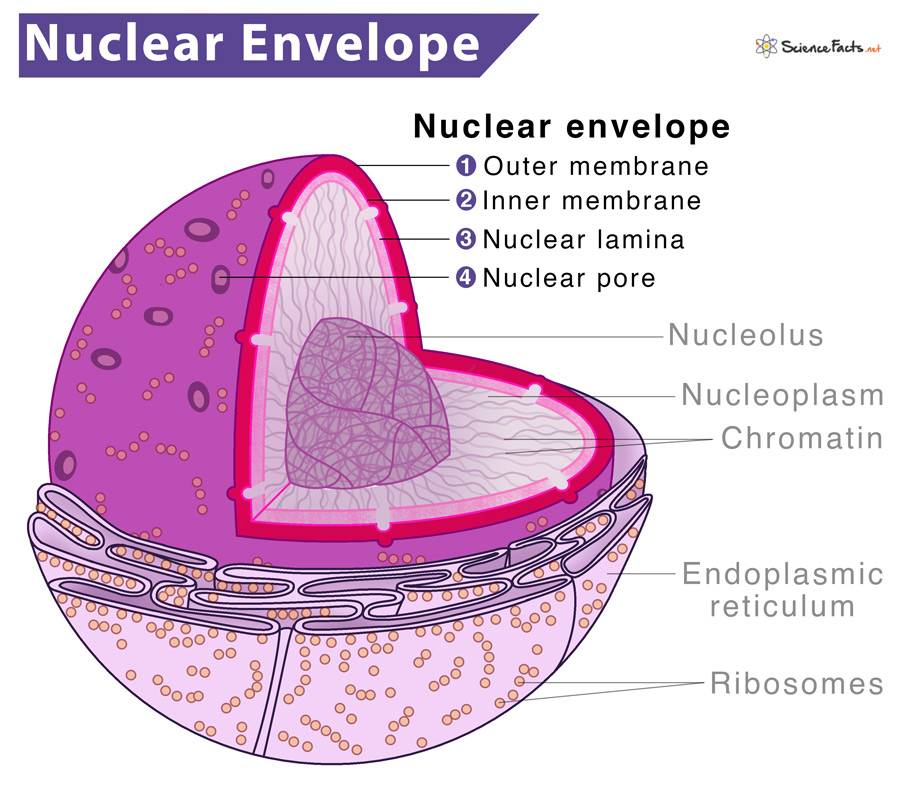Nuclear Envelope (Nuclear Membrane)
The nuclear envelope, also called the nuclear membrane, is the outer covering of the nucleus in eukaryotic cells. It is a double-layered barrier that separates the contents of the nucleus from the cytoplasm in both plants and animal cells. It also protects the genetic material of the cell, the DNA. If the nucleus is a city hall, the nuclear membrane is like the security fence around it.
Among other organelles such as the endoplasmic reticulum, Golgi apparatus, lysosomes, vacuoles, and the plasma membrane, the nuclear envelope is part of the endomembrane system, involved in the selective transport of molecules within the cell and also with the external environment.
Structure of Nuclear Envelope
It comprises two concentric membranes separated by an intermembrane space of about 20-40 nm called the perinuclear space. The two membranes are connected by nuclear pores controlling the movement of substances in and out of the nucleus. The inner nuclear membrane has a meshwork of protein filaments known as the nuclear lamina.
Recent research suggests that the nuclear envelope is not a spherical coat. However, the surface cleaves or invaginates, producing channels forming tubules in the nucleoplasm.
What is it Made of
The different parts within the nuclear envelope are:
1. Outer Membrane
It is a double-layered lipid membrane studded with ribosomes participating in protein synthesis. The outer membrane thus separates the cytoplasm from the perinuclear space. It is continuous in many places with the rough endoplasmic reticulum, so the space between the inner and outer nuclear membranes is directly connected with the lumen of the endoplasmic reticulum. The outer membrane contains a large number of proteins.
2. Inner Membrane
It is also made of the lipid bilayer that separates the perinuclear space from the nucleoplasm. The inner membrane is connected to the outer membrane by nuclear pores. It is covered in a nuclear lamina that stabilizes the nuclear envelope, giving the nucleus its shape.
3. Nuclear Pores
A protein-made hole of approximately 120nm in the envelope allows small molecules and ions to diffuse into the nucleus. There are approximately 1000 nuclear pores in a vertebrate cell.
Nuclear Pores are also responsible for transporting RNA and proteins from the nucleus into the cytoplasm. The nuclear pores pass through both inner and outer membranes.
Small molecules pass through the nuclear pore by passive diffusion. Large molecules are marked by a nuclear localization signal (NLS), a sequence of amino acids that bind to the proteins and function as chaperons through the nuclear pore. Proteins and RNAs are transported out of the nucleus with the help of a nuclear export sequence (NES).
When does the Nuclear Envelope Dissolve
During cell division by mitosis, the nuclear envelope begins to break down or disappear at the end of the prophase. This phenomenon happens with the help of specific enzymes within the cell. A new nuclear membrane again reforms around the chromosome during the telophase stage.
Differences in Plant and Animal Cell Nuclear Envelopes
The animal cell nuclear membrane contains animal-specific proteins on the surface of the envelope, which is different from the fungal or plant nuclear membranes. However, some pore-forming proteins are unique to plants.
Animal cells have centrosomes, structures that help organize DNA when the cell is preparing to divide. In contrast, plants lack these structures and rely entirely on the nuclear membrane for the organization during cell division.
Functions of Nuclear Envelope
Thus nuclear envelope performs several vital functions in the cell:
Main Function
The primary purpose of the envelope is to separate the chromosomes from the cell’s cytoplasm and other contents. It also protects the delicate inner contents of the nucleus, including the DNA.
Other Roles
- Allows selective entry of small as well as large molecules through the nuclear pores
- Allows communication between the outer and the inner membrane
- The inner membrane with the nuclear lamina gives the structural framework to the nucleus
FAQs
Ans. Nuclear membranes permit selective entry and exit of molecules across the nucleus in the same way a cell membrane controls the movement of molecules across the cell. Like the cell membrane, the nuclear membrane is made of a lipid bilayer with embedded proteins.
Ans. DNA.
Ans. No
Ans. No, bacteria being a prokaryote, does not have a cell membrane.
-
References
Article was last reviewed on Thursday, July 28, 2022




